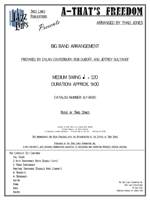A-THAT'S FREEDOM
Arranged by Thad Jones, Prepared by Dylan Canterbury, Rob DuBoff, and Jeffrey Sultanof

Cat #: JLP-8685
$85.00This item usually ships within 1 business day.
Questions?
Please call +1-518-587-1102 or email us.
Edition: Jazz Big Band Arrangement
Description: Swing - Advanced
Publisher: Jazz Lines Publications
Although it was originally intended to be a vehicle for trombonist Al Grey with the Count Basie Orchestra, the Hank Jones composition/Thad Jones arrangement of 'A-That's Freedom' (the "A" is pronounced "Uh") became one of the early staples of the Thad Jones-Mel Lewis Orchestra's book of arrangements. Its modified 16-bar blues form does a wonderful job of taking several key Basie tropes and updating them with a decidedly modernist bent.
Following an open piano solo and a brief rising sax line, the arrangement's most distinct feature is introduced: a steadily churning march feel in the rhythm section, with the trombones and one trumpet outlining the harmony. This underpins the delightfully cutesy melody, played by muted trumpets, flutes and tenor saxes, before giving way to a trombone solo at measure 37. The melody should feature heavily swung and clipped 8th notes, and an overall bright and playful demeanor.
The backgrounds behind the trombone solo begin to sneak in at measure 61. These backgrounds continue to build in rhythmic and melodic complexity around the trombone solo's final chorus before exploding into an all-out shout chorus at measure 85. The brass leads the charge with the saxes weaving an intricate counter line around them, with the intensity continuing to build until some screaming trumpets herald a challenging but thrilling unison trombone line at measure 101. The trumpets and saxes shout some "amens" as things continue to corkscrew and spiral upward, with everything coming together in dissonant glory at measure 117.
A quick piano solo shepherds the band back to the march-tempo feel from the beginning at measure 125, with the horns paired off the same way as before. This continues most of the way through the rest of the chart, minus a brief two measure break at measure 133. Things continue to wind down until the woodwinds play the main melody riff one last time to lead into a pleasant but slightly sour brass chord.
Both alto saxes double on flute, and baritone sax doubles on clarinet.
2 Alto Saxophones (Both Double Flute)
2 Tenor Saxophones
Baritone Saxophone (Doubles Clarinet)
4 Trumpets
4 Trombones
Guitar
Piano
Bass
Drums
Trumpet 2: Opt. F6
Trombones 1-4: C5








